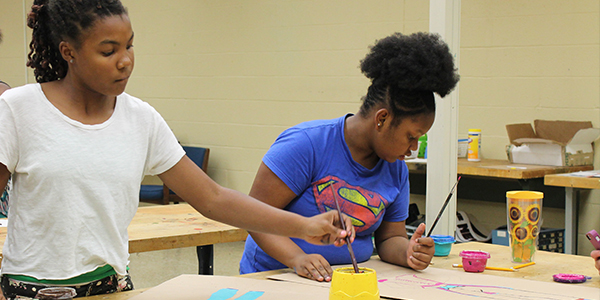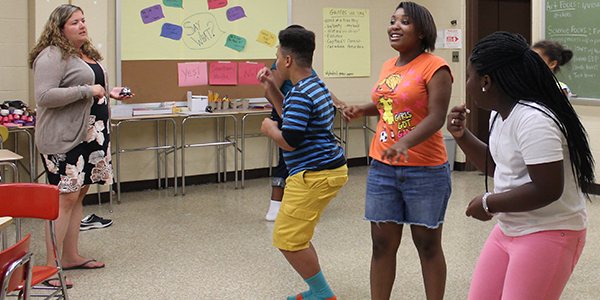Blog
Reflecting on the Teaching Artist Institute
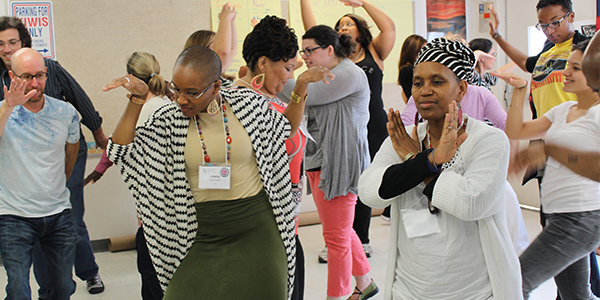
The 2014-2015 Teaching Artist Institute (TAI) Seminar is already underway, but we wanted to share some reflections from artists who have graduated from the program. Here’s what they had to say about the experience:
As a full-time preservationist of acoustic Delta Blues from the 1920s and 1930s, I must make my history of Blues show academically relevant to the curriculums of Maryland and Virginia schools. I completed the TAI training program in 2009, and the course completely transformed my understanding of how I can support the current teaching standards in schools with my music programs.
As Young Audiences knows better than anyone, all the arts are under tremendous pressure to prove their relevance to school systems that are struggling to meet national testing standards in different disciplines. What I learned from my TAI training is that the arts serve a valuable role in preparing students with the 21st Century thinking skills they need for their future success in our rapidly changing world.
By creating a residency with a language arts teacher as my partner, I was able to use songwriting to teach students figurative writing skills. Without the TAI training, my school music programs would not be as academically relevant to the school’s goals. This connection is critical for the arts to survive in our schools, not as a reward for difficult academic work, but as a means to help students meet their academic goals.
The TAI program is well-run by dedicated educators and artists. It is challenging, rigorous, and exposes artists, teaching artists, and professional educators to each other’s thinking styles. This program deserves support, and I hope it continues to transform serious performing artists into skilled teaching artists.
– Curtis Blues, Blues Musician, Exploring Math and Music by Making a One String Guitar
I had never thought of myself as an educator, at least not in the traditional sense. Musically, there is always an underlying truth or teachable moment I try to impart. However, now I needed to do so in a structured, educational format. Although the curriculum was challenging, I am ever so grateful for having gone through the process. The fellowship with the teachers and other artists truly cannot be measured. As an artist, mentally you have to re-wire your brain to remember that it is not about you or a performance; it is about what the children learn and take away from the experience. A few months later I had the opportunity to return to the school for a musical performance for a general assembly. My class was so excited to see me and the feeling was more than mutual. For that reason alone, it was a journey worth taking.
– Uncle Devin, Musician and “Drumcussionist,” Uncle Devin’s World of Percussion
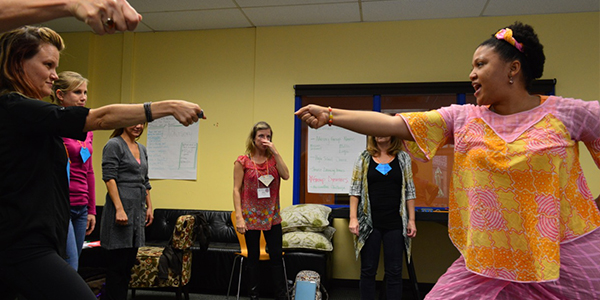
TAI gave me such an appreciation for the life of the classroom teacher. Not only did I learn how to plan and sequence a project into realistic, meaningful lesson plans, I learned a whole new vocabulary and some best practices of a strong teacher as well. Field testing my lessons with my teaching partner gave me real world practice in collaboration, classroom management, solid preparation and flexibility.
TAI is also a rare opportunity to work and learn side-by-side with artists from other disciplines. I met so many energetic, thoughtful, creative people who are not only committed to their art, but also to making a difference in the lives of children. It was incredibly valuable to me to be stretched and out of my comfort zone. As a visual artist, I found that experiences in music, dance and drama helped me move out of my head and in to my body. I learned that this whole body engagement is something that I want to bring to students when I lead them in the visual arts.
On the last day of TAI we were asked to say one word that summed up our experience. My word was “ALIVE.” That pretty much says it all.
– Pam Negrin, Visual Artist, Transformative Textiles: Weaving Together Math, Literacy and History and
Collaborative Stitching: Connecting and Inventing with Needle and Thread
TAI is an amazing opportunity where artists, educators, and staff truly collaborate to help process, define, and designate the importance of art in the classroom. I loved the guided lessons, hands on experience, and being around such amazing, talented individuals. I feel like this experience helped to shine a new light on my own experiences as a classroom teacher and now a teaching artist.
– Bridget Cavaiola and Michael Harris, Baltimore Improv Group, Life is Improvised!
The staff and artists who coached us through TAI opened a whole new level of integrated content, planning, and instructional skills to us. The opportunity to develop new programming for excited young artists, alongside engaged education professionals in so many unique environments has grown our vision as an organization. This fall, three more team members will begin TAI. Best professional development around!
– Matt Barinholtz, FutureMakers, It’s Alive: Kinetic Creature Lab!
I really felt like I was re-energized in my way of thinking and the facilitators brought a plethora of knowledge to the table. I appreciated their ability to listen, answer questions, and make the experience fun, interactive and simply enjoyable.
– Valerie Branch, Modern Dancer, Exploring, Creating, and Dancing with our Friends!
Arts for all

This week, Washington Post reporter Valerie Strauss wrote about why the arts are, more often than not, the first budget cut at public schools serving predominately low-income students–even though much research has supported why the arts are critical to a child’s development. These schools’ tight budgets force them to prioritize the subjects covered in standardized tests that both measure students’ achievement as well as teachers’ ability. Ms. Strauss argues that the focus on testing has forced educators to ignore what they know about the positive and transformative impact of the arts in the classroom.
Less fortunate children have been on the receiving end of what I’d call an emergency-room approach to education —one that addresses only the parts of a child thought to be in most dire need of attention. Their curriculum may consist solely of reading, writing and mathematics – the subjects tested on high-stakes exams.
Ms. Strauss notes how, for privately funded and operated schools, the approach to the arts can be starkly different. These schools proudly highlight the arts and their importance to developing well-rounded students and individuals. With adequate funding, arts learning opportunities are not only available but celebrated.

Young Audiences has seen this disparity in access to the arts in Maryland and is striving to close the gap so that all students have the chance to learn in and through the arts. Since its launch in the winter of 2009, our Access for All Initiative has subsidized programs for students in low-income Baltimore City Public Schools to ensure that all students have equitable access to the best artists and educational arts experiences that our state has to offer. The initiative offers three rounds of grant funding each school year to schools that serve a majority of low-income students and do not have regular arts programming.
Young Audiences awarded a total of $29,600 in funding to 16 Baltimore City schools in the first round of Access for All grants awarded earlier this week to start the 2014-2015 school year. These funds will be used to bring Young Audiences artists and ensembles to students through arts-in-education programs this fall. Schools can choose from a steel drum assembly, creating a ceramic mural during an artist-in-residence program, an African drumming workshop, and many more.
Ms. Strauss summarizes why the arts are critical to the education process, writing:
Arts transport. It’s often said they are an essential part of what makes us human – and an element of that is the ability to imagine another reality, apart from the one we are living, a skill essential to resilience and ambition. Children already living a in a narrowed world need more access to the arts, not less.
Young Audiences agrees. One day, every school–no matter its resources–will value the arts for their ability to inspire and engage students in learning. Until then, we will be working to increase access to the arts so that Maryland students have the opportunity to imagine, create, and realize their full potential through the arts.
Learn more about the Access for All Initiative and the next grant application deadline.
Meet our new artists: Noa Baum
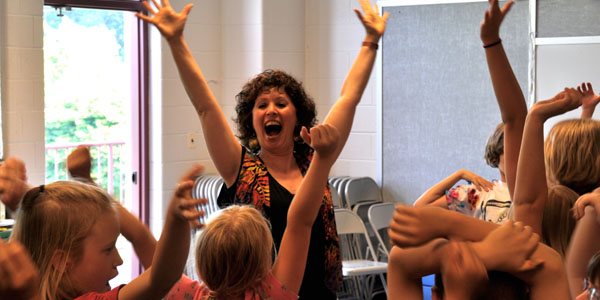
During the last two years, our roster has grown in size to encompass new artists, ensembles, and art forms. From slam poets to improvisers to Capoeira masters, these new artists are undeniably unique.
To introduce audiences to our new artists, we’ll be posting interviews with those who recently joined our roster, giving them a chance to share more about themselves and their experiences with Young Audiences so far.
Israeli-born Noa Baum, who joined the Young Audiences roster in 2013, is an internationally acclaimed storyteller who uses mesmerizing voices, impeccable timing, and warm authenticity to captivate audiences and confront important topics. Read on to learn how she got involved in storytelling and why she believes it’s so essential.
What is your background as an artist?
I was an actress in Israel at the Khan Theatre, a repertory theatre in Jerusalem. I studied acting at Tel Aviv University, studied with Uta Hagan, and received my Master’s from New York University in Educational Theatre. I started as an actress, but I wanted more. There’s actually a story about why I became a storyteller: I didn’t get an acting part I wanted, so to make ends meet, I got a job doing a story hour with kids in Tel Aviv. The way that the children reacted there was very powerful, and I wanted to learn more about the power of drama and story.
How did you hear about Young Audiences?
I moved to the east coast after living in Israel, and I’ve worked in the area ever since. I heard about Young Audiences when I arrived, and I auditioned and was accepted onto the roster.
What made you decide to become a Young Audiences roster artist?
I really like what Young Audiences does for artists. As an artist, it’s hard to market yourself to the schools by yourself. Working in schools is only part of what I do—I do programs for adults as well—so I wanted someone to take care of the marketing for me because it’s a lot of work. Young Audiences is very dedicated. It’s a lot of really good people working and keeping ongoing relationships with the schools and the school districts.
Have you had any programs through Young Audiences yet? What was the most memorable part?
I’ve been really grateful for this year because, as a first year artist, I’ve gotten to work with a lot of schools. The most memorable part has been the flexibility and support of the staff. With Young Audiences, I feel that I have a home and people to support me. As an artist, it feels really good to know that I can focus on my art because I have people taking care of the logistics.
Why do you believe art is important for every student to have access to?
I think art offers a holistic engagement of the brain, the heart, the body, and the whole self. As humans, art is the way we make meaning of who we are, why we’re here, and what this world is made of. Art has never been separate in the development of humanity, but unfortunately, we live in a society where we’ve started separating it. Art has become this extra thing, something that can be cut from the budget because it’s not as important. I don’t think it’s something extra. I don’t even think art is a subject as much as it’s a way of being. The more we integrate the arts into the subjects that we teach, the more we help the students learn and become who they are.
What does your art form in particular teach students?
Our brain processes information through stories. It’s how we remember and how we learn. Storytelling is the best teaching tool that I know—all of the great teachers and leaders of the world have been great storytellers. For me, storytelling teaches a lot of things, the most important being connecting with yourself. It’s an art form that asks you to participate and connect with your creative life force.
I think another amazing and powerful thing that storytelling teaches is listening in a deep, authentic, and fun way. From a very young age, we tell children to be quiet and listen. We expect them to be obedient and listen to instructions, but we don’t offer practice that teaches them how. One of the best ways to teach how to listen is to create an experience where listening is supported, such as a storytelling performance. Storytelling helps cultivate listening because you really have to listen to be able to imagine.
Storytelling works on a cognitive level as well. There’s a lot of research showing that if you want kids to be good writers, they have to be exposed to a lot of oral language. Writing and reading are basically connecting signs to things in your brain. The more words you’ve been exposed to orally and the richer the language you have in your head, the faster you can connect it to words on paper. If you’re looking at words and you don’t know what they mean or have no experience with them, reading and writing will always be a struggle. But if you know what “blossom” means, for example, and if you’ve heard it many times, you can connect the letters to the meaning faster.
Storytelling helps us emotionally connect the mind and heart. You may not remember all the intricacies of a story, but you’ll remember how you felt when you heard it, and sometimes, that can be lifesaving.
Learn more about the Noa’s offerings through Young Audiences here.
Keep an eye out for more interviews featuring our newest roster artists! See past new artist interviews here.
Training that transforms artists and teachers

In a recent blog post for the Washington Post, Alvin Crawford, CEO of Knowledge Delivery Systems, addresses fundamental issues with the current professional development offerings for educators. He cites a 2009 report which found that “when asked about their experience in professional development, ‘most teachers reported that it was totally useless.’” The substantial financial investment the U.S. makes in teacher development ($2.5 billion in 2012 according to U.S. Secretary of Education Arne Duncan) is not meeting the needs of many teachers, or in turn, students.
The Teaching Artist Institute (TAI), did not set out to be a teacher professional development program, but as the program starts its eighth year this fall, it is clear that it is succeeding where many traditional professional development workshops are not. TAI also has gained attention for how it provides teachers with creative and natural tools for implementing Maryland’s Common Core College and Career-Ready Standards through the arts.
TAI is a statewide program made possible through the partnership of the Arts Education in Maryland Schools Alliance, the Maryland State Arts Council, and Young Audiences/Arts for Learning. It was founded to train teaching artists to create curriculum-aligned arts programs for classrooms. Since its start in 2007, the program has graduated more than 110 artists and has repositioned the role of artists in education in Maryland. Teaching artists were once perceived as performers—able to entertain, and perhaps share another culture with students—but they were a distraction from the school day, a break from the classroom. Through TAI, artists have demonstrated the value they bring to the classroom as educators.
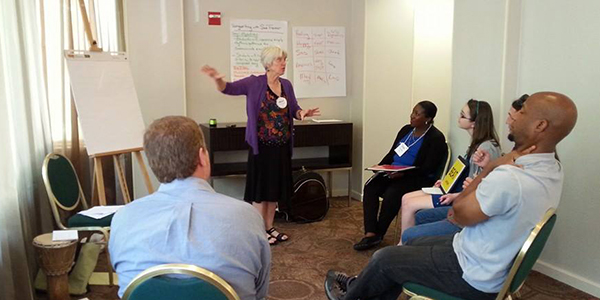
See more photos from the 2014-2015 TAI Seminar here!
TAI-trained artists are critical partners to teachers of any subject, using their art form to creatively address the ever-changing curriculum and standards to which teachers are held accountable. TAI fosters partnerships between teaching artists and teachers, requiring artists to collaboratively plan and teach with an assigned teacher. Through this collaboration, teachers experience the gifts a teaching artist brings to the classroom and learn how the arts can be used to engage children in learning. While TAI was not created for teachers, teachers report it improves their own practice of arts integration and reinvigorates their passion for teaching.
In his post, Mr. Crawford shares what teacher professional development needs to entail to be effective for teachers and to positively impact student achievement:
Teacher development studies…have shown over and over again that simply exposing a teacher to a new concept or skill has little to no classroom impact because most professional development opportunities for educators are still lecture style – telling, showing, and explaining how something can be done.
And when the “learning” is finished, we push teachers back into the choppy waters of their classrooms without so much as a life preserver; they’re given very little or ineffective ongoing support from their district.
To be transformative, strategic professional development needs to be 50 hours or more plus less formal and ongoing interaction and peer engagement to refine skills and model successes. It must also be tailored by subject, grade level and type of student.
By developing an effective training program for artists, TAI has also grown to offer a professional development opportunity for teachers which fits Mr. Crawford’s definition of “transformative.” The 70-hour TAI Seminar begins with a three-day workshop, which includes sessions led by master teaching artists and opportunities for participants to develop and share their knowledge in small groups. Pairs of artists and teachers then work independently during the course of several months to co-create an arts residency program which integrates the artist’s expertise with the curriculum and to test and refine their new program by piloting it with students in the teacher’s classroom.
While TAI was not designed to address the teaching practice of educators, it continues to build a community of impassioned artists and teachers who want to work together to transform teaching and learning through the arts.
Learn more about the TAI program and see photos from the 2014-2015 TAI Seminar. Listen and read recent reporting by WYPR, Maryland’s public radio station, on how TAI teacher and artist participants are creatively addressing Common Core through the arts: Meshing Common Core and Arts Standards and Arts and Common Core—a Natural Fit.
Opportunity Schools are a spot of hope

Much research has suggested that students from low-income families often struggle in school compared to their more affluent peers. However, the Maryland Campaign for Achievement Now (MarylandCAN) published a report in April that seems to dispel this belief. After studying schools throughout Baltimore City, MarylandCAN found that eight public schools with large populations of low-income students are doing the unthinkable: repeatedly outperforming overall state proficiency rates. Young Audiences is a proud partner to seven of the eight schools featured in the report that believe, as we do, that the arts are a valuable tool in engaging students in learning across all subjects.
The highlighted schools are Cecil Elementary, The Empowerment Academy, Hamilton Elementary/Middle, Liberty Elementary, Medfield Heights Elementary, The Mount Washington School, Thomas Johnson Elementary/Middle, and Tunbridge Public Charter School.
Some of the city and state’s highest concentrations of students from low-income households attend these schools; however, for the past two years, at least half of the tested grades have performed above the state proficiency rates on the Maryland School Assessment. The report names these schools “Opportunity Schools,” arguing that they are “beacons to prove what is possible in Baltimore.”
What exactly do these schools have that allows them to break the link between poverty and lower academic achievement? MarylandCAN writes that it comes down to effective leadership. This leadership often comes in the form of a strong principal, the report notes, pointing to inspiring leaders such as Joe Manko, principal of Liberty Elementary–also a standout partner of Young Audiences.
Congratulations to all the Opportunity Schools on their success. It’s because of your determination that the educational opportunity gap may finally come to a close.
Meet our new artists: Baltimore Improv Group
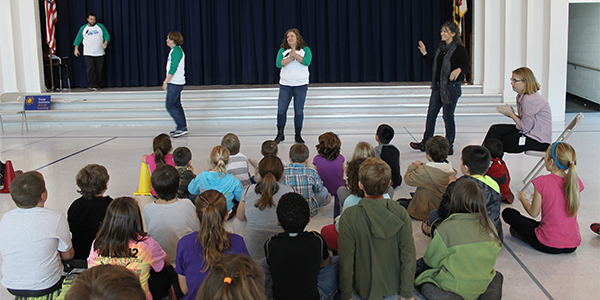
During the last two years, our roster has grown in size to encompass new artists, ensembles, and art forms. From slam poets to improvisers to Capoeira masters, these new artists are undeniably unique.
To introduce audiences to our new artists, we’ll be posting interviews with those who recently joined our roster, giving them a chance to share more about themselves and their experiences with Young Audiences so far.
The Baltimore Improv Group is a talented ensemble that came aboard our roster in 2013, and their performances and residencies never fail to evoke laughter and learning. Read on to find out why they became a Young Audiences roster artist, what they learned through our Teaching Artist Institute, and why they believe improv works so well in the classroom.
What is your background as an artist?
The Baltimore Improv Group is celebrating its 10th year as a theatre company in Baltimore. We started small but have grown close to 60 performers, and we perform 90+ shows a year, including our annual Baltimore Improv Festival. We also teach classes to adults, teens, and children. Our performers have studied and trained all across the country, and we continue to host the best improvisers in Baltimore.
How did you hear about Young Audiences?
Our Education Director, Bridget Cavaiola, worked with Young Audiences for years in her position as the Residential Life Director for the Upper Chesapeake Summer Center for the Arts. The center would bring in Young Audiences artists to perform for its campers. She knew it would be a perfect fit for BIG and made the suggestion that we audition.
What made you decide to become a Young Audiences roster artist?
Improv is such a natural fit with children. It encourages risk taking, creativity, and collaboration. We have hosted our own kids’ shows and classes but knew this would be a perfect match for us.
Have you had any programs through Young Audiences yet? What was the most memorable part?
YES! We had more than 10 assemblies at schools this year and our first residency, too! We are looking forward to more in the coming school year. Some of our favorite memories are watching the students come up on stage and perform in front of their peers and receive that amazing confidence boost that comes from taking a risk within a supportive environment! We certainly have traveled Maryland quite extensively, and we will certainly remember the fun trek to Flintstone Elementary School in Allegany County!

You recently completed the Teaching Artist Institute Seminar this spring. What was your favorite part of the program? How has that experience changed your approach to a program or your teaching practices?
The Teaching Artist Institute is an amazing opportunity where artists, educators, and staff truly collaborate to help process, define, and designate the importance of art in the classroom. We loved the guided lessons, hands-on experience, and being around such amazing, talented individuals. We felt that this experience helped to shine a new light on our own experiences as a teaching artist.
What does your art form in particular teach students?
Improv teaches a lot! Listening skills, taking risks, collaboration, the power of “yes,” learning from failure and mistakes, and much more!
Why do you believe it is important for every student to have access to the arts?
Art is the glue that solidifies education for so many kids. It allows them to access their own creativity and instills a level of respect and ownership over a child’s education.
Learn more about the Baltimore Improv Group’s offerings through Young Audiences here.
Keep an eye out for more interviews featuring our newest roster artists!
It takes a village

On a Monday afternoon in late June, students filled the Goodnow Community Center for the Summer Showcase, a vibrant display of visual and performing arts. The art shown was created by students, families, and community members through programs with Young Audiences teaching artists. Young Audiences has partnered with Goodnow since 2008 to bring a combination of arts assembly and residency programs to students attending the spring afterschool and summer programs at the center, which are made possible through generous funding from the Macht Fund of THE ASSOCIATED.
“We’re very fortunate that we have been able to have Young Audiences work with the Goodnow Community Center for the past six years,” said Gloria Jenkins, director of the center. “Our children have grown through their help.”
Those who stopped by the Summer Showcase got a taste of Young Audiences’ programs immediately when walking through the door, as students’ photographs taken with artist Christina Delgado were displayed by the entrance. These stunning images varied from full portraits to up-close snapshots.
First to perform at the showcase was Young Audiences roster ensemble Illstyle and Peace Productions, a dance company whose work focuses on the movement and spirit of Hip Hop. In her introduction for the group, Gloria noted, “When we’re planning events, the students always remind me to ‘get those boys that dance.’”
See more photos from the showcase here!
Illstyle and Peace Productions’ performance, titled NO Bullying, STOP Bullying: Let’s Be Friends, incorporated contemporary and old school dance moves with the positive message of acceptance. Throughout the show, cheers could be heard from all corners of the packed room. The program’s message was clear: when asked why they shouldn’t bully others, students passionately replied that they should treat others the way they want to be treated.
Acting as a backdrop for Illstyle and Peace Productions’ performance was a mural students created with the help of Young Audiences visual artist Danyett Tucker. “We came together and thought of a positive message we wanted to share with the community,” Danyett explained. The students decided on a quote from Harriet Tubman about following your dreams:
Every great dream begins with a dreamer. Always remember, you have within you the strength, the patience, and the passion to reach for the stars to change the world.

“We’re hoping that it will be used in performances for years to come,” said Danyett of the final product.
Coming together as a village and a community was the theme of the afternoon. It was especially prevalent during the unveiling of the “Mural Without Borders” artwork adorning the Goodnow Community Center’s facade. A sixth-month-long project, the work was created by members of the community with ceramic artist Herb Massie. It depicts the community’s past and present.
“The mural involved different aspects of the community to help put it together,” Rev. Kevin Bacon, Baltimore City Fire Dept. Chaplain said. “Police officers, the church, and schools all got involved.”
Retired Baltimore City Police Officer Craig Singleterry added, “People always say it takes a village. Well, this is our village.”
Though the project brought together all members of the community, it seemed to especially impact students. Rita Crews, a teacher at Hazelwood Elementary who helped students with the mural, shared, “The students were always eager to come in, even on Saturdays. They were the ones reminding me that we had to get to work.”
Barbara Combs, artist and art educator, believes that this interest in art has a practical application, noting that there “isn’t any career that art doesn’t touch.”
For Officer Singleterry, it’s also about showing students that they can do more. “Programs like these give students a new outlook on what they can do, from poetry to dance to music,” he said. “Young Audiences has brought more into their view.”
Summer learning comes to a close
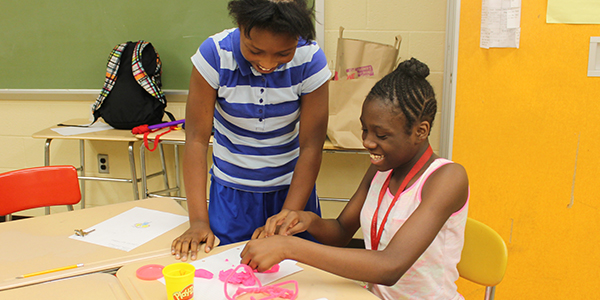
See photos from the Young Audiences arts-integrated summer learning site!
The summer can be a time for fun in the sun with family and friends, but for many students across the country, it is a time of uncertainty. Without school, many at-risk students are left without adequate supervision, access to regular, healthy meals, and opportunities to participate in engaging and constructive activities. On average, all children can lose approximately two months of learning from the previous school year during the summer months without engaging education activities, and for low-income students, the loss is even greater. More than half of the achievement gap between low-income students and their more affluent peers can be attributed to the unequal access to summer learning opportunities.
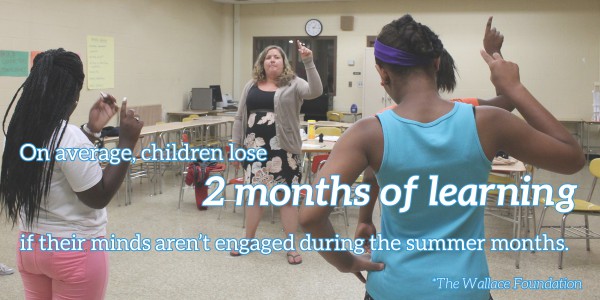
For five weeks this summer, Young Audiences again partnered with Baltimore City Public Schools to combat summer learning loss through a free math- and science-focused summer camp opportunity for Baltimore City middle school students. Young Audiences artists provided arts enrichment activities at seven Baltimore City 22nd Century Pioneers Summer Camp sites. In addition, for the first time, Young Audiences managed an eighth completely arts-integrated camp site at Edmondson Westside High School.
At the Young Audiences camp, morning math and science classes were co-taught by Baltimore City teachers and Young Audiences artists, who explored STEM subjects through the arts. Students had a choice in the art form they focused on during afternoon enrichment classes, including dance, photography, illustration and mural painting, improvisational theatre, Hip Hop, steel drum, or VEX robotics. The camp also included field trips, giving students the chance to apply their knowledge outside of the classroom.
The program was a learning opportunity for participating teachers as well, some of whom were new to arts integration as a teaching practice. Co-teaching with Young Audiences artists gave teachers the opportunity to try out a different way to approach each lesson, growing their knowledge of the arts and the natural connections that exist between core subjects and the arts.

In a recent survey of 500 U.S. teachers, 66 percent said it takes at least three to four weeks to re-teach content from the previous school year to get their students up to speed at the start of each new school year. At Edmondson Westside, the arts made learning fun and students both stayed intellectually engaged so they would not fall behind in their classes this coming school year, and also discovered a new way of learning through the arts. Students had the opportunity to develop their knowledge in math and science in a hands-on way, learning how the length of sound waves relates to the pitch of each note on a steel drum, or how a photographer or illustrator uses mathematical ratios to compose a piece. Students learned about themselves as they tried new things; took risks during classroom activities; and showcased what they had learned for others.
Read more about the Young Audiences arts-integrated summer learning site and see photos from this summer here.
Leaping headfirst into arts integration
By Grace Galarpe, Baltimore City Public School teacher
When I got involved in the Young Audiences and Baltimore City Public Schools 22nd Century Pioneers Arts-Based Summer Camp, I wasn’t sure if I was in the right place at first. Even though I’ve seen arts integration in the news, this summer was my first time really working with it. It was my first time working with Young Audiences, too, so when they told me that this program was all about arts integration, I was curious to learn more.
As a high school teacher, I’ve had the opportunity to collaborate with other core subject teachers before, but a collaboration with an artist? This was my first time and the idea interested me. In the past, I’ve used the arts in my classroom in the sense that we would sometimes draw or dance or sing. If I did incorporate the arts, it was separate. These activities would be after instruction or after school. The program this summer, where arts integration happened within the instruction, used a completely different method.
I was paired with Valerie Branch, a dancer. Before Valerie and I started teaching, we did lesson planning. Looking back, we consider this the biggest factor in our success because the planning helped us gain a greater understanding of how we would integrate the arts into our lessons.
I was very fortunate because both of us took the program very seriously. We would do thorough planning and would really talk about what was going to happen the next day and the next. Everything that Valerie and I accomplished this summer was possible because we had time to plan together. I wasn’t just going into a classroom where I would do everything by myself; it was a partnership.
See more photos from the Young Audiences arts-integrated summer learning site!
Our lessons weren’t always perfect, but since the teacher and the artist planned together, we could always reflect and revise–not just one of us, but both of us. We helped and respected each other, and as the summer went by, we became very comfortable with one another. When Valerie and I would sit down together, she made me feel confident about where the arts would come in and how we would make it possible. She made me feel more comfortable with her art form, too, and because of this, I could easily explain the elements of dance to students.
This summer, I realized that a dance activity can be incorporated with a science activity using the same concepts and vocabulary. That was amazing to me. At first, I wondered, “How will my students benefit from this collaboration and integration of the arts?” I now feel that arts integration gives students the chance to learn at a different level because we are able to touch multiple intelligences. I believe that our students achieved a deeper understanding of the science concepts and vocabulary that we taught them due to the integration of the arts into our teaching. They were able to apply what they had learned, not only through science but through dance, too.
Sometimes during the science instruction, students would ask: “Why do we need to learn this?” I would respond that they needed to know the terms and concepts so that we could apply them to our next dance choreography, and then they would get excited. When Valerie would talk about the elements of dance at the same time as the science, the students would be able to perform a dance choreography based on something related to science, such as pollution. That was a really wonderful outcome.
I can now see that if arts integration is a regular part of a classroom, it helps increase academic achievement and positive intervention regarding behavioral problems. I could tell that the arts were a huge help in attendance in our classroom, too, and I was so happy that the students looked forward to our class every day.
The arts also helped create responsibility. For example, Valerie and I decided that we needed to do something that would make the students understand that they had an obligation in the classroom. As a part of our teaching, we did an activity we called “Human Mirror,” which incorporates dance movements that develop a sense of responsibility. It requires listening, following directions correctly, being observant, and an understanding of what it means to be a leader and a follower. This was a great success for our class. I could sense that the students also gained respect for both of us. They called both me and Valerie artists, which surprised me. I was like, “Oh wow, I’m an artist!”
[youtube http://youtu.be/7laf55H68VE]
If ever given the chance, I would tell teachers who haven’t used arts integration not to be afraid of co-teaching with an artist. If there were an opportunity for me to be involved in another arts integration program, I would gladly do it. I’ve realized that in programs like this, the artist and teacher can become more than just teachers. I believe that they can do more than just share concepts or explain the academic side of things: they can inspire students’ lives.
Read more about the Young Audiences 22nd Century Pioneers Arts-Based Summer Camp site and see photos here.
How do we make learning fun?

By Chanel Traboldt, Third Grade Teacher at Harford Heights Elementary and Young Audiences Public Programs Summer Intern
Two middle school girls sit in the back of the classroom. One of them is sneaking a look at her cell phone under her desk; the other is braiding her hair. They are in a morning class during the first week of the Young Audiences and Baltimore City Public Schools 22nd Century Pioneers Arts-Based Summer Camp, and neither girl is looking at the front of the room or listening as the teacher, Ms. Moss, begins a math lesson on integers.
For a school teacher, like me, this can be the scene of many early mornings. The question you ask yourself each time is: “How do I better engage my students in their learning?” This often can seem like an impossible task. We know that if you make learning fun, students will want to learn. As an educator, there is an urgency to fight the achievement gap and prepare your students with the skills needed to be college and career ready. But now the tricky part: how do we make learning fun?
Young Audiences again partnered with Baltimore City Public Schools to solve this dilemma in July. In addition to providing arts enrichment activities at seven summer learning sites in Baltimore City, Young Audiences and City Schools created the first-ever completely arts-integrated summer learning site at Edmondson Westside High School. All eight sites were a part of the 22nd Century Pioneers Summer Camp, which is a free program for Baltimore City Public School middle school students.
Back in the classroom at the Young Audiences arts-integrated camp site something surprising happens. Ms. Moss continues her math lesson by projecting photographs students took the previous day while working with Young Audiences photographer Christina Delgado. The two girls stop what they were doing and look up. Ms. Moss asks the group what elements of photography are being used in each image and how these elements relate to what they are learning about integers. The girls raise their hands to join the conversation.
See more photos from the Young Audiences arts-integrated summer learning site!
During my time at Young Audiences’ site, I saw that teachers and artists had found a solution to many teachers’ student engagement woes. Integrating the arts into daily lesson plans allowed students to create, explore, express, have fun, and most importantly, to learn.
At the Young Audiences camp, nearly 150 students explored math and science concepts through the arts in classes and arts enrichment activities led by Baltimore City teachers and Young Audiences artists during the five-week program. Students chose the art form they would focus on during afternoon enrichment sessions, with choices including dance, photography, illustration and mural painting, theatre, Hip Hop, steel drums, and VEX robotics.
In another class, I saw a group of chatty sixth-graders sitting in the corner go completely silent to listen to steel drum musician Kevin Martin play musical phrases the class had created using what they had learned about ratios.
An unenthused student turned frustration into joy while drawing blueprints for a cage to carry a wild boar across a lake of alligators in visual artist Danyett Tucker’s eighth-grade math class.
Students, who were at first more focused on their weekend, turned that energy into an intricate dance routine about pollution in dancer Valerie Branch’s class.
As a teacher witnessing these moments of transformation, I am amazed at how easy it is to engage students in learning. The key is to understand that learning and the arts are not separate entities. By combining the two elements and creating arts-integrated educational lessons, students are truly able to learn while having fun.
Read more about the Young Audiences 22nd Century Pioneers Arts-Based Summer Camp site and see photos here.
Taking summer learning beyond the classroom
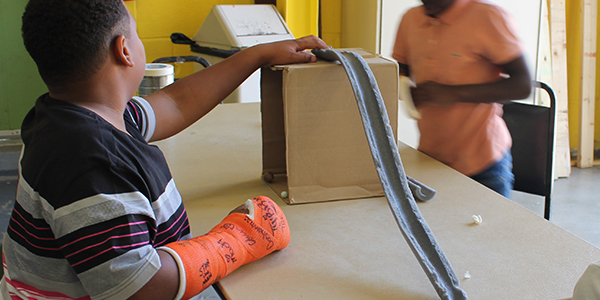
During the past few weeks, nearly 150 middle school students have dived into math and science concepts through the arts at the Young Audiences and Baltimore City Public Schools 22nd Century Pioneers Arts-Based Summer Camp. Students have learned how ratios are used in photography and how the physics of sound affect each note played on a steel drum. Through these art forms, and many more, students have been engaged in learning this summer so that they are prepared to hit the ground running this school year.
While most of the learning goes on inside the school, students have also had the opportunity to take their knowledge beyond the classroom walls on field trips. These excursions allow students to continue their hands-on learning in a new atmosphere, applying the skills and knowledge they’ve acquired throughout the summer.
The first trip was a visit to the Baltimore Museum of Industry, where students learned the ins and outs of technology and put their own engineering skills to the test. In one activity, students worked together in small groups to create a track that would carry a wooden ball and drop it into a can. This required them to go through the five steps of solving an engineering problem: plan, get materials, build, test, fix, and re-rest. Students were forced to adjust and readjust their designs before finally reaching their goal, usually resulting in loud cheers.
Students received another challenge: creating an artistic interpretation of the word industry. Groups joined together, combining their knowledge and creativity to come up with dances, skits, and songs that showed what they had learned that day.
See more photos from summer learning!
The following week, students traveled to Baltimore’s Artscape, America’s largest free arts festival organized by the Baltimore Office of Promotion and the Arts. Surrounded by artists of all disciplines, the students put on a show of their own at the Station North Stage, showcasing what they’ve been working on during their arts enrichment classes. The show opened with a lively Hip Hop dance performance from Jamaal Collier and Alicia Shaw’s Hip Hop class. After the performance, one student explained the four pillars of Hip Hop, the most important one being knowledge. Next, Valerie Branch and Heather Tuttle’s dance class got the crowd cheering with a dance set to Ariana Grande and Iggy Azelea’s “Problem.” Kevin Martin and Kevin Older’s students also got to show off their steel drum skills.
Even those who didn’t perform on stage took part in their own form of art-making. Throughout the day, Christina Delgado’s photography students captured Artscape from behind the lens, while Danyett Tucker’s illustration students filled up their sketchbooks with drawings of everything from festival attendees to graffiti on buildings.
Bridget Cavaiola’s improv class performed an exercise called “Improv Everywhere.” All over the festival, they held compliment battles, gave flowers to strangers, and posed as wax statues, making them the target of many curious stares and even a few pictures. See this group in action in the video below!
[youtube http://youtu.be/hg-sdwpGYQg]
Read more about the arts-integrated learning happening at the Young Audiences 22nd Century Pioneers Arts-Based Summer Camp site and see photos here.
Celebrating Failure: Lessons learned in a sixth-grade classroom
By Stacie Sanders Evans, Young Audiences/Arts for Learning Executive Director
Last week I visited the classroom of teaching artist and improv master Bridget Cavaiola and science teacher Heather Tuttle, who are teacher partners in our 22nd Century Pioneers Arts-Based Summer Camp in West Baltimore. Like in all of our classes, these two teachers were “starting with the art” by warming up brains and bodies with the drama game “Big Booty.” This particular game required kids to call on each other using a number instead of their name, and the goal of the game was to keep the it going as long as possible and as quickly as possible, without someone “messing up” by forgetting who had what number. (I realize this description doesn’t explain why this game is called Big Booty but just stick with me here…)
The first time a student messed up in Big Booty, everyone clapped. I wasn’t sure what was going on but smiles ensued and the game started over. Quickly another kid forgot which number they were and when their number was called, the game stalled. Once again everyone clapped and Bridget looked over at me to clue me in and said, “We celebrate our failures in here.” The game continued, and as the kids’ brains warmed up and the fear of making a mistake in front of their peers dissipated, the need to clap wasn’t as frequent. When they did clap, they laughed, they shrugged it off, and they quickly moved on.
When it came time to move on to the science lesson, the teachers wanted to recap the lesson from the day before about the engineer design process. Bridget realized she had mistakenly erased the board which had listed all the key terms shared yesterday and Heather realized she forgot her notebook for reference. Oops! I don’t think the situation could have been better orchestrated, in that moment Bridget and Heather, modeled “the way” by shrugging off their mistake and asked the class, “What can we do?”
See more photos from the Young Audiences arts-integrated summer learning site!
The kids immediately started calling out the key terms they learned the day before. “Imagine!” “Investigate!” “Test!” In a quick minute all the key terms were there. I noticed each term was delivered with a gesture. The day before, the students came up with a move that conveyed the essence of each word. This lesson recap evolved into sixth-grade boys and girls (remember those awkward years?) moving their arms, hands, and heads in space as they defined the engineer design process.
Bridget and Heather and their sixth-graders are onto something. The simple act of celebrating failure creates a safe space for trying something, even if you are unsure if you are right or if you might look silly. Just imagine what is possible when you remove that fear–real opportunities for exploration, experimentation, reflection, and growth emerge.
Read more about the arts-integrated learning happening at the Young Audiences 22nd Century Pioneers Arts-Based Summer Camp site and see more photos here.















